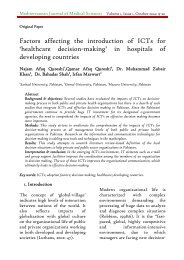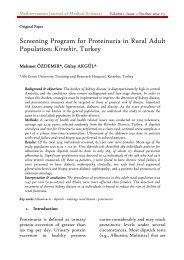Issues and Prospects of e-health in Pakistan
Background & objectives: In connection with access to information in developing countries, information flows through existing networks of communication is a main theme in the current IS literature . Methods:Information-intensive infrastructure is a requirement for information dissemination due to the shortage of network infrastructure in the majority of developing states. It is verified by many researchers that information managing technologies with their main purpose of ‘handling information’ have the advantage to enhance already existing technologies by making better information-communication a priori to new ICT innovations .Presently health information system infrastructure is deficient in resources to meet the demands and needs of increasing population in developing countries. Health care systems of developing countries have major barriers like poverty and lack of technological sophistication. Results:The basic difficulties or barriers in using information technologies include poor or inadequate infrastructure, insufficient access to the hardware and inadequate or poor resources allocation. By eliminating these barriers population health status can be improved in developing countries. Interpretation & conclusion: This study aims to determine the main issues and prospects for ehealth in the current situation of developing countries like Pakistan and the way forward for policy makers to manage all issues in future for more effective and rational decision-making in healthcare organizations. Key words: e-health; challenges; prospects; developing countries; Pakistan
Background & objectives: In connection with access to information in developing countries,
information flows through existing networks of communication is a main theme in the current
IS literature .
Methods:Information-intensive infrastructure is a requirement for information dissemination
due to the shortage of network infrastructure in the majority of developing states. It is
verified by many researchers that information managing technologies with their main purpose
of ‘handling information’ have the advantage to enhance already existing technologies by
making better information-communication a priori to new ICT innovations .Presently health
information system infrastructure is deficient in resources to meet the demands and needs of
increasing population in developing countries. Health care systems of developing countries
have major barriers like poverty and lack of technological sophistication.
Results:The basic difficulties or barriers in using information technologies include poor or
inadequate infrastructure, insufficient access to the hardware and inadequate or poor
resources allocation. By eliminating these barriers population health status can be improved in
developing countries.
Interpretation & conclusion: This study aims to determine the main issues and prospects for ehealth
in the current situation of developing countries like Pakistan and the way forward for
policy makers to manage all issues in future for more effective and rational decision-making
in healthcare organizations.
Key words: e-health; challenges; prospects; developing countries; Pakistan
Create successful ePaper yourself
Turn your PDF publications into a flip-book with our unique Google optimized e-Paper software.
Mediterranean Journal <strong>of</strong> Medical Sciences V1, I1 October 2014: 31-52 44<br />
implementation, develop<strong>in</strong>g states<br />
have to th<strong>in</strong>k about the human<br />
factor as well (Durrani & Khoja,<br />
2009).<br />
Though we suggest the use <strong>of</strong> Free<br />
<strong>and</strong> Open Source S<strong>of</strong>tware<br />
(FOSS) (from operat<strong>in</strong>g system<br />
to EHR s<strong>of</strong>tware) but due to<br />
shortage <strong>of</strong> money, these products<br />
are l<strong>in</strong>ked with many challenges.<br />
As these products are “free”, its<br />
users do not have any support <strong>and</strong><br />
ma<strong>in</strong>tenance from development<br />
teams. The government <strong>of</strong><br />
develop<strong>in</strong>g countries needs to set<br />
aside sufficient f<strong>in</strong>ances for staff<br />
tra<strong>in</strong><strong>in</strong>g <strong>in</strong> the <strong>health</strong>care sector.<br />
If e-<strong>health</strong> is to succeed <strong>in</strong><br />
develop<strong>in</strong>g nations it needs to be<br />
take care <strong>of</strong>. We need to develop<br />
our own local abilities <strong>and</strong><br />
<strong>in</strong>frastructure, based on local<br />
dem<strong>and</strong>.<br />
The shared underst<strong>and</strong><strong>in</strong>g <strong>and</strong><br />
collaboration is a coord<strong>in</strong>ated,<br />
synchronous activity that is the<br />
outcome <strong>of</strong> a cont<strong>in</strong>ued effort to<br />
construct <strong>and</strong> uphold a shared<br />
conception <strong>of</strong> a problem.<br />
Cooperation is work<strong>in</strong>g jo<strong>in</strong>tly to<br />
achieve shared goals surrounded<br />
by jo<strong>in</strong>t <strong>and</strong> supportive activities<br />
<strong>in</strong>dividuals look for results which<br />
are advantageous to themselves<br />
<strong>and</strong> helpful to all other group<br />
members. Methodically <strong>and</strong><br />
thoroughly structur<strong>in</strong>g those basic<br />
elements <strong>in</strong>to group learn<strong>in</strong>g<br />
circumstances helps ensure jo<strong>in</strong>t<br />
efforts <strong>and</strong> makes possible the<br />
closely controlled implementation<br />
<strong>of</strong> jo<strong>in</strong>t learn<strong>in</strong>g for last<strong>in</strong>g<br />
success (Kaplan, 2000). The<br />
advantages <strong>of</strong> collaborative<br />
learn<strong>in</strong>g are that persons br<strong>in</strong>g<br />
different ideas <strong>in</strong> a collaborative<br />
environment <strong>and</strong> work on the<br />
way to the growth <strong>of</strong> a shared<br />
underst<strong>and</strong><strong>in</strong>g <strong>and</strong> build<strong>in</strong>g usual<br />
knowledge (Tan , 2005). At<br />
present, the exist<strong>in</strong>g<br />
underst<strong>and</strong><strong>in</strong>g seems to be that<br />
collaboration is a synonym for<br />
high-quality learn<strong>in</strong>g <strong>and</strong> good<br />
educational technology; more or<br />
less any web-based application is<br />
labeled as collaboration<br />
(He<strong>in</strong>zelmann et al., 2003).<br />
Ever <strong>in</strong>creas<strong>in</strong>g charges for<br />
<strong>health</strong>care services <strong>and</strong> fast<br />
<strong>in</strong>crease <strong>and</strong> development <strong>of</strong> the<br />
knowledge have led the doctors<br />
<strong>and</strong> physicians to work <strong>in</strong> a<br />
collaborative way <strong>and</strong> share<br />
knowledge <strong>and</strong> skills. It is usually<br />
understood that <strong>health</strong>care<br />
pr<strong>of</strong>essionals work<strong>in</strong>g <strong>in</strong> a<br />
collaborative style, can deliver<br />
<strong>health</strong>care services <strong>in</strong> a successful<br />
<strong>and</strong> well-organized manner.<br />
Collaborative learn<strong>in</strong>g process can<br />
exchange <strong>of</strong> ideas with<strong>in</strong> little<br />
groups not only enhances <strong>in</strong>terest<br />
between the participants but also<br />
generates <strong>and</strong> encourages critical<br />
th<strong>in</strong>k<strong>in</strong>g. Collaboration <strong>in</strong><br />
<strong>health</strong>care organizations requires<br />
©2014 Mediterranean Center <strong>of</strong> Medical Sciences








